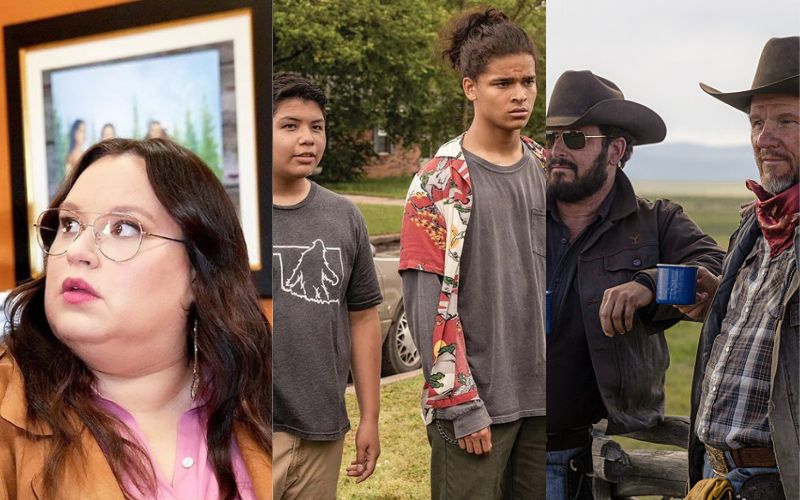
- Details
- By Jenna Kunze
The study, conducted in partnership with the USC Norman Lear Center’s Media Impact Project, analyzes the portrayal of 104 Native characters across 51 series that aired with new episodes between 2020 and 2022. Specifically, the study focused on three series: Rutherford Falls, Reservation Dogs, and Yellowstone.
Overall, the study found that about half of the Native characters represented in scripted TV were poor or working class, and less than 20% committed nonviolent crimes or an act of physical violence.
Additionally, researchers conducted a study surveying 1,200 viewers on the impact of each series on audiences’ knowledge, beliefs, and behaviors.
The study’s results highlight the contrasting impacts of two Native-led shows, Rutherford Falls and Reservation Dogs, against the non-Native-led Yellowstone. Viewers of the former two shows were significantly more likely to agree with policy that supports and centers Indigenous voices, such as the removal of Native American imagery from sports teams and the government’s duty to uphold treaty and trust responsibilities.
Additionally, Reservation Dogs viewers—a show that featured a storyline in season two about a Native teenager placed in a non-Native youth home—were more likely to support the Indian Child Welfare Act (ICWA), a policy aimed at keeping Native American children with Native American families, recently upheld by the U.S. Supreme Court.
Viewers of Yellowstone were less likely to support the U.S. upholding treaty obligations that allow Native Americans to control their own lands, and more likely to feel discomfort with the idea that some practices, such as sacred ceremonies, are not meant to include everyone.
“Not only was viewing series with prominent Native characters associated with knowledge of and beliefs about Native communities, but also with support around very concrete present-day issues, such as ICWA or ending the use of Native appropriation in sports,” Soraya Giaccardi, Senior Researcher at USC Norman Lear Center’s Media Impact Project and lead author of the report said in a press release.
The study also found that involving Native talent both in front of and behind the camera is crucial to a series’ success. Of the 51 series analyzed, two-thirds had no Native talent behind the scenes, yet those that did received better audience reception.
Also, series featuring larger Native ensembles garnered greater critical acclaim, according to the study. While the report paints a mostly positive picture of current on-screen Native representation, researchers caution that this progress could be at risk if the current surge in Native storytelling ends.
Many of the series examined have since concluded, with only four confirmed renewals including Native talent behind the scenes.
In conclusion, the study says that “there is significant room for improvement in representation of Native talent behind the scenes.” Despite an average of 10 Native characters per series, only one in three had any Native writers, directors, or executive producers.
“This analysis reaffirms our long-held belief that when non-Native people tell our stories – even those that may be well-intentioned – there’s a high risk that these stories will ultimately diminish Native autonomy or further stereotypes of our communities,” said Crystal Echo Hawk, Founder and CEO of IllumiNative.
More Stories Like This
What Inspires Indigenous Ballet Dancer Jock SotoGrand Rapids Public Museum Hosts Indigenous Culture Celebrations
In Case You Missed It: Native Bidaské - Julian Brave NoiseCat on His New Book “We Survived the Night”
Santa Ynez Band of Chumash Indians to Host 19th Annual Culture Day on October 18
Cherokee Nation Collaborates with DreamWorks and NBCUniversal to Bring Cherokee-Language Dub of How to Train Your Dragon
Help us tell the stories that could save Native languages and food traditions
At a critical moment for Indian Country, Native News Online is embarking on our most ambitious reporting project yet: "Cultivating Culture," a three-year investigation into two forces shaping Native community survival—food sovereignty and language revitalization.
The devastating impact of COVID-19 accelerated the loss of Native elders and with them, irreplaceable cultural knowledge. Yet across tribal communities, innovative leaders are fighting back, reclaiming traditional food systems and breathing new life into Native languages. These aren't just cultural preservation efforts—they're powerful pathways to community health, healing, and resilience.
Our dedicated reporting team will spend three years documenting these stories through on-the-ground reporting in 18 tribal communities, producing over 200 in-depth stories, 18 podcast episodes, and multimedia content that amplifies Indigenous voices. We'll show policymakers, funders, and allies how cultural restoration directly impacts physical and mental wellness while celebrating successful models of sovereignty and self-determination.
This isn't corporate media parachuting into Indian Country for a quick story. This is sustained, relationship-based journalism by Native reporters who understand these communities. It's "Warrior Journalism"—fearless reporting that serves the 5.5 million readers who depend on us for news that mainstream media often ignores.
We need your help right now. While we've secured partial funding, we're still $450,000 short of our three-year budget. Our immediate goal is $25,000 this month to keep this critical work moving forward—funding reporter salaries, travel to remote communities, photography, and the deep reporting these stories deserve.
Every dollar directly supports Indigenous journalists telling Indigenous stories. Whether it's $5 or $50, your contribution ensures these vital narratives of resilience, innovation, and hope don't disappear into silence.
 The stakes couldn't be higher. Native languages are being lost at an alarming rate. Food insecurity plagues many tribal communities. But solutions are emerging, and these stories need to be told.
The stakes couldn't be higher. Native languages are being lost at an alarming rate. Food insecurity plagues many tribal communities. But solutions are emerging, and these stories need to be told.
Support independent Native journalism. Fund the stories that matter.
Levi Rickert (Potawatomi), Editor & Publisher

